In vivo analysis of the effect of panobinostat on cell-associated HIV RNA and DNA levels and latent HIV infection
- PMID: 27206407
- PMCID: PMC4875645
- DOI: 10.1186/s12977-016-0268-7
In vivo analysis of the effect of panobinostat on cell-associated HIV RNA and DNA levels and latent HIV infection
Abstract
Background: The latent reservoir in resting CD4(+) T cells presents a major barrier to HIV cure. Latency-reversing agents are therefore being developed with the ultimate goal of disrupting the latent state, resulting in induction of HIV expression and clearance of infected cells. Histone deacetylase inhibitors (HDACi) have received a significant amount of attention for their potential as latency-reversing agents.
Results: Here, we have investigated the in vitro and systemic in vivo effect of panobinostat, a clinically relevant HDACi, on HIV latency. We showed that panobinostat induces histone acetylation in human PBMCs. Further, we showed that panobinostat induced HIV RNA expression and allowed the outgrowth of replication-competent virus ex vivo from resting CD4(+) T cells of HIV-infected patients on suppressive antiretroviral therapy (ART). Next, we demonstrated that panobinostat induced systemic histone acetylation in vivo in the tissues of BLT humanized mice. Finally, in HIV-infected, ART-suppressed BLT mice, we evaluated the effect of panobinostat on systemic cell-associated HIV RNA and DNA levels and the total frequency of latently infected resting CD4(+) T cells. Our data indicate that panobinostat treatment resulted in systemic increases in cellular levels of histone acetylation, a key biomarker for in vivo activity. However, panobinostat did not affect the levels of cell-associated HIV RNA, HIV DNA, or latently infected resting CD4(+) T cells.
Conclusion: We have demonstrated robust levels of systemic histone acetylation after panobinostat treatment of BLT humanized mice; and we did not observe a detectable change in the levels of cell-associated HIV RNA, HIV DNA, or latently infected resting CD4(+) T cells in HIV-infected, ART-suppressed BLT mice. These results are consistent with the modest effects noted in vitro and suggest that combination therapies may be necessary to reverse latency and enable clearance. Animal models will contribute to the progress towards an HIV cure.
Keywords: BLT; HIV; Histone acetylation; Humanized mice; Latency; Panobinostat.
Figures
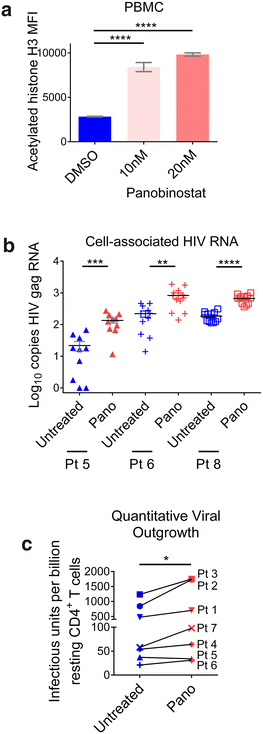
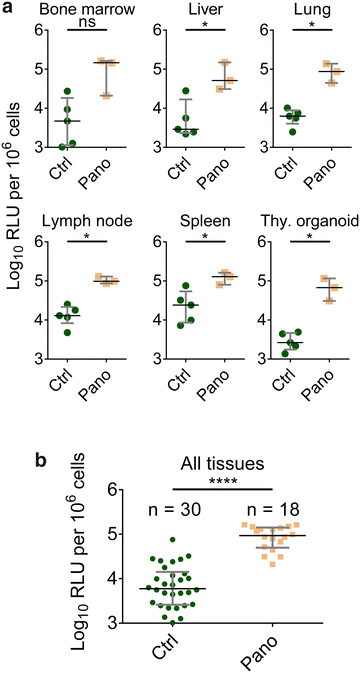
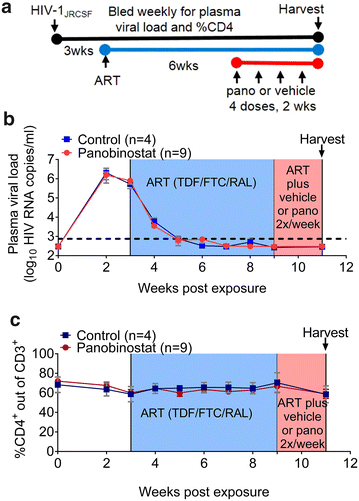
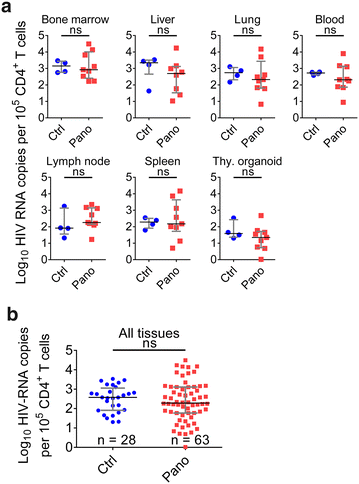
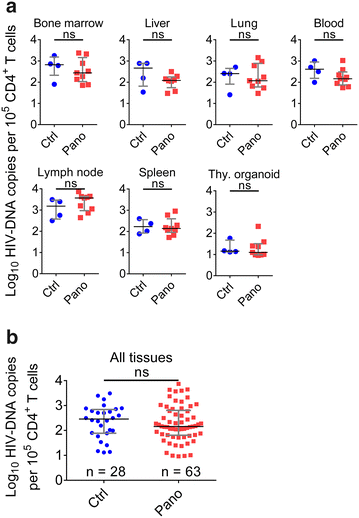
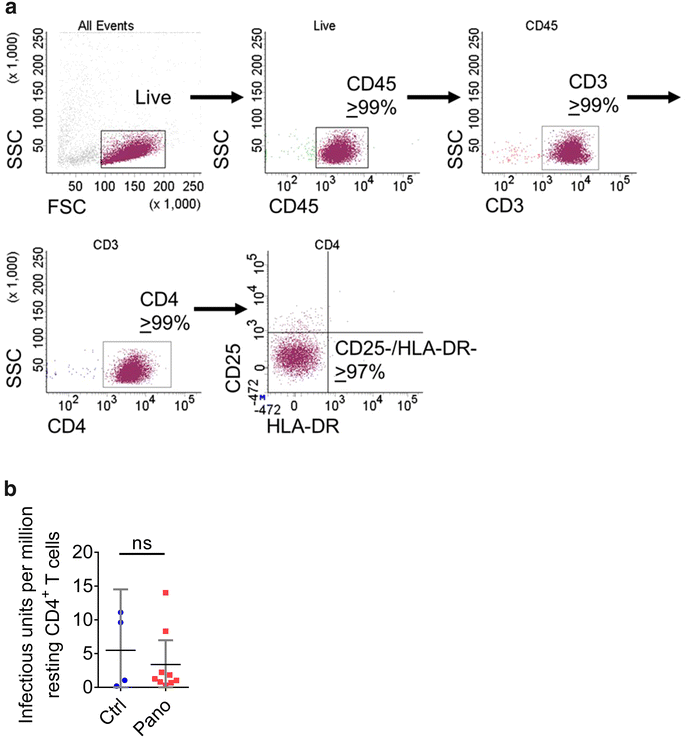
Similar articles
-
Innate Immune Activity Correlates with CD4 T Cell-Associated HIV-1 DNA Decline during Latency-Reversing Treatment with Panobinostat.J Virol. 2015 Oct;89(20):10176-89. doi: 10.1128/JVI.01484-15. Epub 2015 Jul 29. J Virol. 2015. PMID: 26223643 Free PMC article. Clinical Trial.
-
Ex Vivo Bioactivity and HIV-1 Latency Reversal by Ingenol Dibenzoate and Panobinostat in Resting CD4(+) T Cells from Aviremic Patients.Antimicrob Agents Chemother. 2015 Oct;59(10):5984-91. doi: 10.1128/AAC.01077-15. Epub 2015 Jul 13. Antimicrob Agents Chemother. 2015. PMID: 26169416 Free PMC article.
-
Analysis of the effect of HDAC inhibitors on the formation of the HIV reservoir.mBio. 2024 Sep 11;15(9):e0163224. doi: 10.1128/mbio.01632-24. Epub 2024 Aug 13. mBio. 2024. PMID: 39136440 Free PMC article.
-
Getting the "Kill" into "Shock and Kill": Strategies to Eliminate Latent HIV.Cell Host Microbe. 2018 Jan 10;23(1):14-26. doi: 10.1016/j.chom.2017.12.004. Cell Host Microbe. 2018. PMID: 29324227 Free PMC article. Review.
-
Therapeutic Approaches to Eradicate Latent HIV-1 in Resting CD4+ T Cells.Curr Top Med Chem. 2016;16(10):1191-7. doi: 10.2174/1568026615666150901114138. Curr Top Med Chem. 2016. PMID: 26324046 Review.
Cited by
-
HibeRNAtion: HIV-1 RNA Metabolism and Viral Latency.Front Cell Infect Microbiol. 2022 Jun 14;12:855092. doi: 10.3389/fcimb.2022.855092. eCollection 2022. Front Cell Infect Microbiol. 2022. PMID: 35774399 Free PMC article. Review.
-
Influenza Vaccination Can Broadly Activate the HIV Reservoir During Antiretroviral Therapy.J Acquir Immune Defic Syndr. 2018 Nov 1;79(3):e104-e107. doi: 10.1097/QAI.0000000000001829. J Acquir Immune Defic Syndr. 2018. PMID: 30085954 Free PMC article. No abstract available.
-
The inhibitor apoptosis protein antagonist Debio 1143 Is an attractive HIV-1 latency reversal candidate.PLoS One. 2019 Feb 4;14(2):e0211746. doi: 10.1371/journal.pone.0211746. eCollection 2019. PLoS One. 2019. PMID: 30716099 Free PMC article.
-
Cellular Gene Modulation of HIV-Infected CD4 T Cells in Response to Serial Treatment with the Histone Deacetylase Inhibitor Vorinostat.J Virol. 2020 Jun 16;94(13):e00351-20. doi: 10.1128/JVI.00351-20. Print 2020 Jun 16. J Virol. 2020. PMID: 32295913 Free PMC article.
-
HIV-1 latency reversal agent boosting is not limited by opioid use.medRxiv [Preprint]. 2024 Jun 4:2023.05.26.23290576. doi: 10.1101/2023.05.26.23290576. medRxiv. 2024. Update in: JCI Insight. 2024 Nov 22;9(22):e185480. doi: 10.1172/jci.insight.185480. PMID: 37398278 Free PMC article. Updated. Preprint.
References
-
- Davey RT, Jr, Bhat N, Yoder C, Chun TW, Metcalf JA, Dewar R, Natarajan V, Lempicki RA, Adelsberger JW, Miller KD, et al. HIV-1 and T cell dynamics after interruption of highly active antiretroviral therapy (HAART) in patients with a history of sustained viral suppression. Proc Natl Acad Sci USA. 1999;96:15109–15114. doi: 10.1073/pnas.96.26.15109. - DOI - PMC - PubMed
MeSH terms
Substances
Grants and funding
LinkOut - more resources
Full Text Sources
Other Literature Sources
Medical
Research Materials

